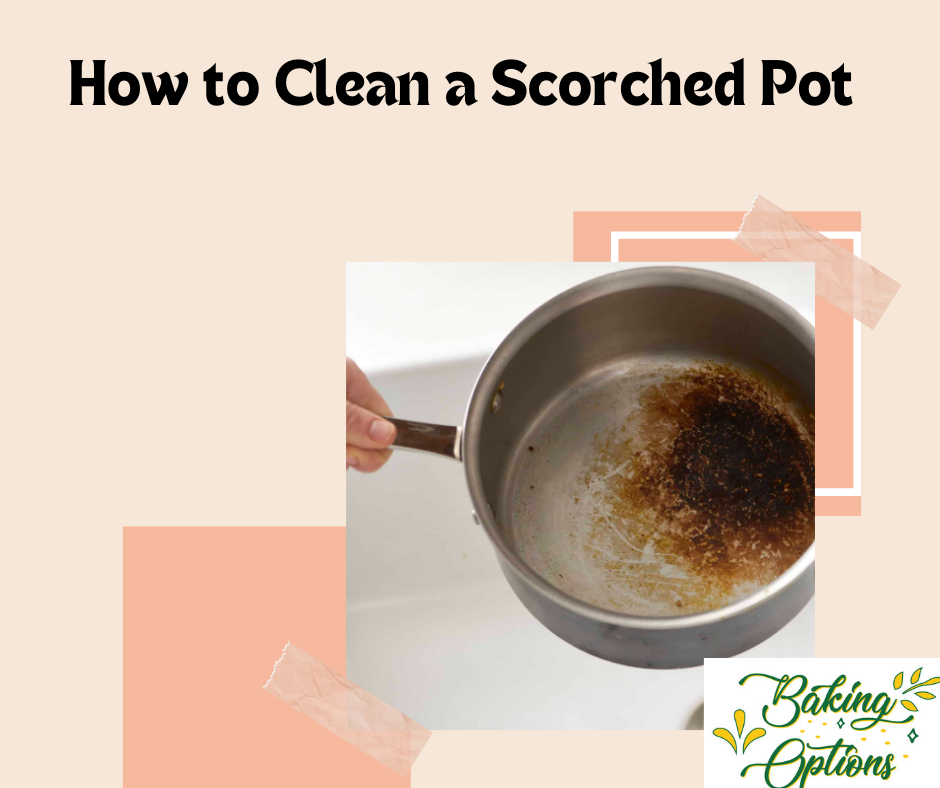If you are cooking and your dinner gets burned or your pan becomes dirty, you need to clean it. Some pans are easy to clean, while others can accumulate a lot of grime and are much harder to clean. In such situations, people become worried about what they should do to keep their utensils clean. So, in today’s article, we will explain how you can clean your cookware, whether burnt or very dirty. Are you excited to learn how to clean a scorched pot?
Contents
How to Clean a Scorched Pot : 8 Easy Methods
Important Note: I have personally tried all these eight methods. I know some other techniques, but I will share these 8 with you because I have tried them. You can use any of these that you find suitable or affordable.
The Bubbly Volcano Method (Baking Soda + Vinegar)
First, take water and vinegar into the pot you want to clean. Then place it on the stove. The quantity of water and vinegar should be about the same as a cup of tea. Then, add two tablespoons of baking soda and boil until bubbles form. When the bubbles appear, remove the pot from the heat, and once it’s cool, clean the pot with a sponge.
Once, I was making spaghetti for my family. It was my first experience, so I ended up burning the spaghetti. Then I remembered this method, so I added all the ingredients to the pot for cleaning. When the bubbles started forming, my brother came into the kitchen and was surprised. He thought I might be doing some magic. However, while it wasn’t a great first experience making spaghetti, it was quite a good one for cleaning the pot.
The Lemon Fresh Fix
This method of cleaning pots is the most impressive and interesting. Following this method can refresh your mind while also cleaning your pot. Here’s what you need to do: First, take two lemons as if you are making lemon juice at home. Then, add them to water and boil them on the stove. But remember, you should do this in the same burnt pot. The fragrance is so pleasant that it will feel like you’re strolling in a garden with fresh air.
The Magic Powder Helper (Bar Keepers)
The method is quite common; many people use it, and I have it available. However, the (Baking Soda + Vinegar) method is more suitable. Let me share how to use it. You shouldn’t directly mix it with water; combine it until it forms a toothpaste-like mixture. Many people don’t do this and complain that it doesn’t work correctly. You should scrub it where there are more spots and rinse it off after 60 seconds, and all the spots will disappear.
When I discussed this method with people, some said that even after using it, we still have to clean the pot, but some find it very beneficial. I don’t know their way of using it, but you should follow the method I’ve described. I assure you it will work.
The Aluminum Foil Magic
It is like seasoning your feasts; pour a pinch of baking soda into the pot, add a drop of water, then use crumbled foils to cleanse the pot. It is such a thing as bathing your pot with silver paper! Light pressure is enough – remember, you are scrubbing and not trying to harm your skin.
Dishwasher Tablet Trick
Take your pot slightly wet, and then rub it like a scrub with a dishwasher tablet. Washing with this is like having a tiny washing dish in your hand. My sister believes this method after using all the regular cleansers and finding this one by accident.
Salt Scrub
Table salt is dissolved in water that sometimes looks like wet sand. Rub this grainy paste on the pot and wash lightly. The process works like a spa session for your utensils and cookware. I remember that day I nearly dropped the salt container when trying this. Oh my, my kitchen looked like I hosted a winter wonderland party!
Baking Soda Treatment
Use water to make a thick paste with baking soda; the thickness should be the thickness of a pancake batter. Apply it to the burned areas and wait for fifteen minutes while you watch your favorite cooking program. Then, scrub away the mess.
Cream of tartar (Super satisfying Method)
Cream of tartar is that fine white powder you see in the spice rack; dissolve it with water to prepare a paste. Leave it wet on the burnt areas for about 30 minutes as you take coffee. Then wash off the grime—it’s as simple as that!
Pro Kitchen Tip: No method working alone? Try combining them! Years back, I tried to boil caramel sauce and got very busy chasing my cat while playing with a laser beam on the floor. Use lemon techniques for a fresh and good-looking smell, then Bar Keepers Friend and the baking soda paste. That pot is still shining today!
Additional Genius Hacks for Cleaning Burnt Pots
So, you’ve tried a few of the methods above, but those stubborn stains still hang on for dear life? Don’t give up just yet! Sometimes, all it takes is a bit of creativity (and patience) to rescue your favorite pot. Let’s dive into a few more tried-and-true hacks that might just be the game-changer you need.
1. The Overnight Soap Soak
Let’s face it: when it comes to burnt-on grime, time can be your best friend. After all, who wants to scrub for hours when you can let science do the work? Simply fill your pot with warm water and squirt in dish soap—don’t be stingy! Leave it to soak overnight. The following day, you’ll find that most gunk lifts off with a gentle scrub—no sweat, no stress, and no scratches on your cookware.
2. Hydrogen Peroxide Magic
Okay, this one’s a bit of a hidden gem. Did you know hydrogen peroxide isn’t just for first aid kits? For those extra tough, baked-on stains, pour a layer of hydrogen peroxide into the pot and heat it gently on the stove. As it bubbles, it works its magic, breaking down all that stubborn residue. Turn off the heat, let it sit for 10 minutes, and scrub it quickly. Voila! A clean pot without the elbow grease.
3. Dish Soap Boil Trick
Here’s a hack for when you’re in a hurry: fill the pot with water, add a dollop of dish soap, and bring it to a boil. Let it simmer for about five minutes. It loosens grease and stuck-on bits like a charm. After it cools, wipe it clean, and you’ll be ready to tackle your next cooking adventure.
4. The Freezer Freeze-Out
This one sounds unconventional, but trust me, it works wonders. If scrubbing isn’t cutting, pop the pot into your freezer for a few hours. Once it’s frozen solid, the burnt food becomes brittle and easier to chip away. Use a spatula to scrape it off gently—no harsh chemicals or hard scrubbing required!
5. Salt as Nature’s Scrub
We already know salt makes food taste amazing, but did you know it doubles as a natural cleaner? Mix table salt with enough water to make a paste for tough stains. It should feel grainy, like wet sand. Use this to scrub the pot, focusing on the burnt spots. It’s like giving your pot a spa treatment! Bonus: no weird smells or harsh chemicals involved.
Proactive Tips to Avoid Burnt Pots (And Headaches!)
Burnt pots are a part of life, but wouldn’t it be better to avoid them altogether? Here are a few simple tips to keep your cookware looking pristine:
- Cook Low and Slow: Medium heat is your best friend unless you’re searing something. High heat increases the chances of food sticking and burning.
- Stay Present: Multitasking might sound great, but it’s the fastest way to forget about a pot on the stove. If you’re busy, set a timer as a reminder!
- Stir Often: Especially for sticky dishes like rice or sauces, frequent stirring prevents food from settling and scorching.
Keeping Your Pots Looking Like New
Once you’ve successfully cleaned your pot, don’t stop there! Here’s how to keep it shiny and in tip-top shape:
- For Stainless Steel: Add a splash of vinegar to the water, wipe the surface, and admire the sparkle.
- For Cast Iron: Always dry thoroughly after washing, and apply a thin coat of oil to prevent rust.
- For Non-Stick: Use only soft sponges to avoid scratching the coating.
The Bottom Line
Accidentally burning your pot doesn’t mean it’s destined for the trash—or a permanent spot in the back of your cupboard. With these simple, effective methods, you can tackle even the toughest messes and bring your cookware back to life.
And hey, next time your spaghetti gets scorched, or your caramel goes from golden to blackened, you won’t have to panic. Just roll up your sleeves (or try the no-scrub hacks!) and get to work. You’ve got this!
So, which method are you excited to try first? Let us know how it worked for you, and keep cooking up those delicious meals—just maybe keep an eye on the stove this time!

